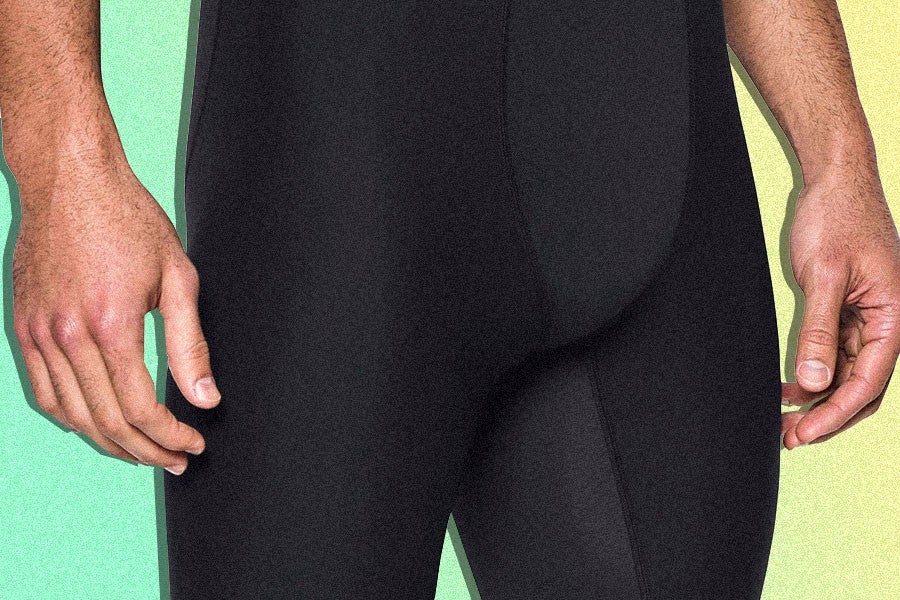Earlier this month, fans at the Košice Peace Marathon in Slovakia were delighted to see 10th place finisher Jozef Urban cross the finish line with his dick and balls dangling out of his running shorts.
Warning: There is frontal male nudity in the following clip.
https://www.youtube.com/watch?v=L26hIqpO9m8
Even aside from the bruised testicles, this is a real shame for Urban, whose entire running career will forever be reduced to a YouTube clip of his scrotum flailing against his pumping thighs.
This, of course, was an accident — the result of a legitimate wardrobe malfunction involving Urban’s running shorts, whose compression lining failed to adequately tame his manhood. But my subsequent research finds that a shocking number of men don’t wear compression shorts at all.
An informal poll of the male MEL staff finds that only two of the nine editorial staffers wear compression shorts while exercising, with one employee admitting he doesn’t even know what compression shorts are. And exercise forums on Reddit reveal that there are a substantial number of men who, despite being fitness conscious, are oblivious to the glorious benefits of spandex short pants. (Many of these posts come from the subreddit r/BigDickProblems, which should indicate why compression shorts are so important.)
So we at MEL, as part of our continued mission to edify the male population, feel it necessary to say: Men, do yourselves and the world a favor and buy some dang compression shorts. They will keep your junk safely constrained in its rightful place while you exercise, so it doesn’t flop wildly while you run, or slam into a barbell while weightlifting. And perhaps more importantly, they will protect your penis and testicles from falling out of your shorts in the gym or on a running path.
Sales of compression shorts have actually increased in recent years with the advent of the “athleisure” trend and the corresponding uptick in sports apparel sales, overall, according to Matt Powell, sports industry analyst at market research firm NPD Group. “The [sportswear] category was really hot for two, three years. There was a huge spike in sportswear sales in 2015. Last year was good, too. But this year, sales have flattened out,” Powell says. “A possible explanation is that, as activewear heated up as a fashion trend, we saw people accumulating those products, and now their wardrobes are all filled out.”
The U.S. compression short market is expected to total $125 million dollars this year, according to NPD research, a 20 percent decline from 2016.
Women account for a slight majority of those sales, though, and we tend to more closely associate compression shorts (and pants) with women. Some obvious examples include the meteoric success of Lululemon and the corresponding rise in women wearing yoga leggings as casualwear. “Tight-fitting apparel for casualwear is probably more oriented to women,” Powell says.
Jason Goldberg, senior vice president of retail commerce at digital ad agency Razorfish, posits that the lack of men wearing compression shorts stems from the rise of e-commerce. “We’re still in the dark ages when it comes to replacing physical shopping experiences for athletic apparel with digital ones,” says Goldberg. “Yet, as much as 25 percent of athletic apparel is now purchased online. And we as an industry have a long way to go to meet the expectations of the digitally enabled apparel shopper.”
Case in point: Many sites don’t specify whether a pair of running shorts comes with a compression short liner built into the garment, Goldberg says, and it’s hard to tell whether a pair of compression shorts is the desired length — some men want their compression shorts to extend beyond the knee of the shorts they wear on top, while others prefer they be shorter.
And that’s to say nothing of fit. The difference between a large and extra-large T-shirt is negligible for many men. But small differences are crucial when the item is intended to be form-fitting. “When you’re dealing with tight-fitting garments, having the correct fit is much more important than with loose-fitting garments,” Powell says.
On a side note, I recently bought a pair of athletic shorts with a compression short lining at a Nike store, only to take them home and discover they didn’t fit, because I was too dumb and lazy to check the size chart in the store. Now I have to go all the way back there and hope I can swap them out for a larger size, which might not even be doable because I (again, being dumb) threw out the receipt before I tried them on.
Not that compression shorts are a foolproof solution. Urban is a professional runner, so it’s likely he did have a compression lining in his shorts, and in this case, they failed him. A similar thing happened to NFL defensive lineman Chris Jones, who came out of his shorts while running the 40-yard dash at the 2016 NFL combine.
But I still strongly believe that every little bit of compression and protection helps. That trip back to the Nike store will be more than worth the hassle if it means avoiding Urban’s fate.
